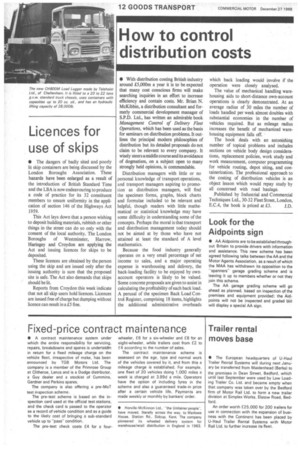How to control distribution costs
Page 14

If you've noticed an error in this article please click here to report it so we can fix it.
• With distribution costing British industry around ,E5,000m a year it is to be expected that many cost conscious firms will make searching inquiries in an effort to increase efficiency and contain costs. Mr. Brian N. McKibbin, a distribution consultant and formerly commercial development manager of S.P.D. Ltd., has written an admirable book Management Control of Delivery Fleet Operations, which has been used as the basis for seminars on distribution problems. It outlines the principal modern philosophies of distribution but its detailed proposals do not claim to be relevant to every company. It wisely steers a middle course and its avoidance of dogmatism, on a subject open to many strongly held opinions, is commendable.
Distribution managers with little or no personal knowledge of transport operations, and transport managers aspiring to promo tion as distribution managers, will find the specimen forms, graphs, block charts and formulae included to be relevant and helpful, though readers with little mathematical or statistical knowledge may have some difficulty in understanding some of the concepts. Perhaps the moral is that transport and distribution management today should not be aimed at by those who have not attained at least the standard of A level mathematics.
Because the food industry generally operates on a very small percentage of net income to sales, and a major operating expense is warehousing and delivery, the back-loading facility to be enjoyed by ownaccount operators is likely to be valued. Some concrete proposals are given to assist in calculating the profitability of each back load. A perusal of the specimen Back Load Control Register, comprising 18 items, highlights the additional administrative overheads which back loading would involve if the operation were closely analysed.
The value of mechanical handling warehousing aids to short-distance own-account operations is clearly demonstrated. At an average radius of 30 miles the number of loads handled per week almost doubles with substantial economies in the number of vehicles required. But as mileage radius increases the benefit of mechanized warehousing equipment falls off.
The book deals with an astonishing number of topical problems and includes sections on vehicle body design considerations, replacement policies, work study and work measurement, computer programming for vehicle routing, depot siting, and containerization. The professional approach to the costing of distribution vehicles is an object lesson which would repay study by all concerned with road haulage.
Published by Industrial and Commercial Techniques Ltd., 30-32 Fleet Street, London, E.C.4, the book is priced at £3. J.D.












































































